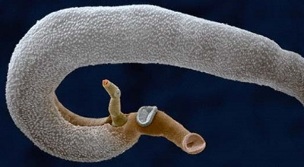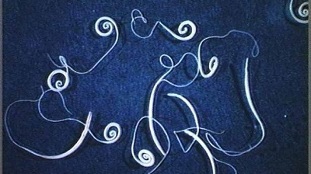Helminths are parasitic worms. To do this, they use intermediate and primary hosts, which are nourished by cells or tissues and receive nutrients and vitamins that enter the body for the host. Worms in the human stomach, as well as in the intestines or other tissue structures, poison the body with toxins during their vital activity.
Types of parasites entering the body from the stomach
Each type of parasite can develop in the part of the human body where the best conditions for reproduction and nutrition are created. Certain types of parasites can pass from organ to organ in the body. Infection with parasites occurs in different ways. The most common way parasites enter the human body is through food. Problems can be avoided by following basic hygiene rules - wash your hands before eating, and take good care of your food.
Parasites do not live long in the human stomach due to the effect of hydrochloric acid on their membranes. The most common foreign microorganisms that parasitize the human body are:
- Ascaris- have the ability to penetrate the intestines through the ducts of the liver and lung structures. In the small intestine, roundworms develop for sexually mature individuals.
- Schistosomes- in advanced cases, affects the liver tissue, causing the development of oncological diseases and degeneration of the hepatobiliary system.
- Hookworms- causes digestive problems. The most dangerous for the human body are hookworms and necrosis. Localization of parasites mainly in the duodenum. Hookworms can enter the human body only through the stomach. Parasites have the ability to invade the skin, causing allergic reactions in the form of itching, burning and redness.
- Toxoplasma- the simplest parasites that often affect the human body. The disease progresses very easily, often invisible to humans. Serious consequences for the body occur only in the case of a sharp weakening of immunity.
- Wide ribbon worm- localized in a small part of the human intestine. It can reach several meters in length. The parasite causes a deficiency of cyanocobalamin (vitamin B12) and folic acid in an organ. Toxic-allergic reactions of the body are not excluded. Infection occurs when eating fish affected by larvae.
- Beef lentewormis a worm that causes the development of a disease such as teniarinchiasis. The bovine tapeworm parasite, which enters the human body through food, passes through the stomach through the membrane under the influence of gastric juice. Absorbents are released and the parasite can easily adhere to the mucous membrane of the small intestine. Symptoms of bovine tapeworm in the body are abdominal pain, nausea and bloating. The patient loses appetite and may suffer from dyspeptic disorders (eg, belching). In some cases, infection with bovine spongiform encephalopathy is a manifestation of allergic reactions in the form of urticaria on the skin.
- Pig lentewormis a helminth measuring up to 10 meters. It belongs to one of the largest worms that infect the human body. The eggs of the parasite passing through the stomach lose their shells under the influence of hydrochloric acid. The larvae that hatch from the eggs spread to all tissues of the human body and cause the development of cysticercosis. Cysticercosis poses the greatest threat to the nervous system.
- Vlasoglavis a roundworm that causes trichocephalosis. Signs of occupation may not last long. In complex cases, symptoms of ulcerative colitis or Crohn's disease may occur with a large accumulation of parasites. There is pain in the abdomen, loss of appetite and fecal fluid. Strips of blood and mucus are noted in the stool.


Symptoms of parasites and worms in the gastrointestinal tract
Alien organisms, which lead a parasitic lifestyle in the host's body, disrupt the functioning of many organs, cause inflammatory processes and seriously destroy body tissues.
Parasitic individuals in the intestinal tract use nutrients from food intended for the host to grow and reproduce. The consequences for people are sad. There is a serious deficiency of trace elements and vitamin complexes in the body.
Children's organisms are most at risk.
Against the background of severe helminthiasis, both physical and psychological growth and normal development processes are seriously disturbed. Helminths have a perfect adaptation to the host's body and the ability to live for decades. Helminth eggs show an obvious resistance to environmental factors.
Different types of helminthiasis in the digestive system can disrupt the digestive process by releasing specific toxins for protection and disrupting enzymatic activity. Helminthiasis can cause gastritis and other dyspeptic disorders.
Symptoms of parasitic infections can vary greatly. In the vast majority of clinical cases, there is discomfort and pain at the site of the parasite. Thus, helminths, which live on the skin, damage the dermis, which leads to allergic reactions. Parasites localized in the lung structures can cause disturbing coughs or shortness of breath. Symptoms of dwarf tapeworm infection include weakness in the body, memory impairment, abdominal pain and headaches. Sometimes nausea and persistent vomiting are diagnosed as stomach ulcers.
Fecal disturbances, bad breath, painful sensations in the intestines, or indigestion are often associated with the movement of parasites in the digestive system.
The effect of foreign microorganisms on the human body as a whole causes the following symptoms:
- increased vulnerability;
- headache attacks;
- insomnia;
- swelling;
- itching and itching on the skin of an allergic nature;
- bronchial asthma attacks.
In addition, the body's overall resistance decreases against the background of changes in the immune system. In young children, helminthiasis manifests itself with a delay in physical and psychological development.
Diagnostics
Diagnostics combines studies to identify larvae or worm eggs.
The biological materials for diagnosis are:
- feces;
- urine;
- sputum;
- composition of the duodenum;
- bile duct secretion;
- rectal crumbs;
- spot from perianal space;
- muscle fibers;
- blood.
Based on the macroscopic detection of helminths and their particles, eggs and larvae can only be detected by laboratory examination under a microscope.
Acute helminthiasis phase caused by larvae of parasites in tissues or parasitic toxocariasis, trichinosis, cystocercosis, trichocephaly, involves the use of serological samples as follows:
- RSK- complementary binding reaction;
- HA- indirect agglutination;
- ELISA- immunofluorescence analysis;
- AHL- lysis agglutination.
In some cases of helminthiasis, a reliable diagnosis can be made only by special ultrasound examinations, computed tomography, X-ray examination and endobiopsy.
Treatment
The treatment for helminthiasis can be very different. Science knows more than 300 types of helminthiasis, but the main parasites that cause changes and systemic intoxication are roundworms and flatworms. They are generally divided into intestinal and non-intestinal. When prescribing therapeutic measures, it is important to take into account a number of characteristics that are unique to a particular class of helminths that are harmful to human health.
To get rid of helminths, a specialist prescribes a whole treatment regimen, and it is important to take into account the frequency of infection of some organs, the intensity of infection, the degree of intoxication and the duration of helminthiasis. This allows you to determine the most effective means.
Medications
An individual therapy regimen is developed to combat the diagnosed helminth type. The specialist prescribes the appropriate drug based on the patient's test results.
Folk remedies
Traditional medicine can help get rid of parasites at home.
You can use the following recipes for the treatment of helminthiasis:
- Wormwood seeds,should be ground and mixed with honey. Take 1 teaspoon 3 times a day for 3 consecutive days. Effective for ascariasis
- Wormwood infusionis prepared as follows - chop the herbs, pour boiling water over them, infuse all night. Strain the infusion in the morning and take 3 times a day. The course of treatment is up to 3 weeks. Effective for ascariasis & enterobiosis
- Pumpkin seeds.These can be used raw, dried or powdered. The powder is mixed with honey and the drug is taken on an empty stomach. The tape fights worms. You can make a weld from pumpkin seeds. One kilogram of seeds is crushed in a mortar, poured 1. 5 liters of hot water and put in a water bath. You do not need to bring it to a source. Drink the broth on an empty stomach.
- Infusion of pomegranate peels.Dried and crushed pomegranate peels, pour boiling water, cool and take 1 teaspoon 3-4 times a day. The course of therapy is 7 days.
Preventive measures
If the rules of personal hygiene are not followed, it will be necessary to constantly remove parasites from the body, which will have a negative impact on the condition of the body as a whole.
It is important to follow the following basic hygiene rules to prevent:
- Avoid close contact with animals;
- Keep your hands clean - wash after each exit;
- It is important to keep the living space clean, wet clean, wash dishes with detergent;
- If you have children at home, it is recommended to wash children's toys with soap, especially after walking;
- Wash vegetables and fruits under running water, preferably hot or even hot, because worm eggs contain a sticky substance that prevents them from separating from the surface;
- Eat meat and fish only after initial heat treatment;
- Drink clean water and avoid tap water as it may contain lamblia and schistosomes.
Helminthiasis is not only a concern, but also very harmful to the human body. Neglected helminth damage causes disorders in the functioning of the whole organism. It is important to take timely preventive measures to prevent infection.




























